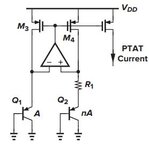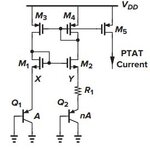Ata_sa16
Full Member level 6
- Joined
- Mar 29, 2016
- Messages
- 343
- Helped
- 59
- Reputation
- 118
- Reaction score
- 58
- Trophy points
- 28
- Location
- Milky Way Galaxy, 179° 56′ 39.4″
- Activity points
- 2,221
Hi all,
I have been struggling with this PTAT current source.
It works fine but problem is, it does not have enough slope. I did a lot of tuning but I never got better than this.
Do you have any suggestions ? it can be totally different circuit. I just need a PTAT bias current source with higher slope.

Thank your for your time.
I appreciate.
I have been struggling with this PTAT current source.
It works fine but problem is, it does not have enough slope. I did a lot of tuning but I never got better than this.
Do you have any suggestions ? it can be totally different circuit. I just need a PTAT bias current source with higher slope.

Thank your for your time.
I appreciate.





